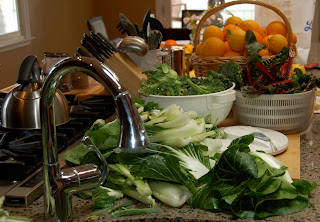Speaking of flying... near this time last year I discovered the nest of Mockingbird eggs. It was a highlight of my garden as you may remember if you're a frequent reader. If you're new, read last June's blog entries. They are my favorite so far, I think. While its fresh on my mind and timely conversation, let me mention the insect activity that I've witnessed. On the heels of a Master Gardener's class on Entomology and Integrated Pest Management, I went out to survey my roses with a magnifying glass (or loop). I have been battling the aphids with hose showers now and then, but I never stopped to actually get involved in their world. I am not taking the aphids on as warmly as I did the Mockingbirds, but the activity on the rose stem is stunning. It's these occurrences in the garden that fascinate me and keep me coming back for more.
Before we dive into Spring, I must share the tail-end of the winter harvest. Afterall, vegetable gardening is not just about the planting, it is also about the harvesting, which can be a lot of work in itself. You can imagine the washing, drying and preparing that went along with this typical loot. Bok choy is in the forefront followed by broccoli, chard and way too many oranges and lemons.
A soil tidbit
As we prepare for our warm season gardens, keep in mind not to till your soil too aggressively. You want to minimize disturbance to your soil and only fuss with the top layer. Let the earthworms do your rototilling. Now is a good time to add organic matter in the form of compost that you've made yourself or purchased from the nursery. Remember that compost is an amendment and not a fertilizer, but it does wonders for soil structure, water retention and the ability for your plants to absorb nutrients.SPRING IS THE TIME TO TRY SOMETHING NEW
Kathy asked for some information on composting. First off, there are many ways to compost and you need to find what works for you. I used a silly little book called, Backyard Composting, by Harmonious Technologies in Sebastopol. In addition, Basic Composting, by Ebeling is great if you want to build your own bin. There are numerous sites on the Internet as well. Find something that will help you decide how you'd like to collect and store your material. For example, I collect kitchen scraps in a Kitchen Compost Pail from the Container Store.
When it fills up, I empty it into a large, white paint bucket that sits outside my back kitchen door. I bought it at Home Depot.
When that fills up, I empty it into a structure I have in the backyard. I built this using six shipping pallets. It has worked well, but it is definitely a slow method. The section on the right is the holding area, while the section on the left is the active area. In this picture, you can see that the left side has decomposed quite a bit.
The key is to build a pile layering equal portions of green material and brown material. Then when you are ready, you start the process of turning your pile and keeping it moist. Maintaining an adequate moisture level will create a nice home for micoorganisms, earthworms and insects. It should be about as wet as a squeezed-out sponge. My pile does not generate high heat because of the size and open construction. If you use a closed container such as, BioStacks, you can create a much faster system. I am looking into a system called The Compost Tumbler. One of my Master Gardener classmates highly recommended it and she has been composting for over 20 years.
If you want a faster system, it is best to shred or chop up your material. The smaller the material, the faster it will decompose.
WHAT IS GREEN?
Green is your nitrogen.
Anything that was originally cut from a live plant or derived from a vegetable-eating animal. All fruit and vegetable scraps, coffee grounds, tea (even the bag), egg shells (best to break them down first), yard clippings, grasses, weeds, flowers, horse manure.
WHAT IS BROWN?
Brown is your carbon.
Leaves, straw, sawdust, cardboard
I mainly use leaves.
Compost is good everywhere! It is not just for the vegetable gardeners. Flowers, shrubs and even trees like compost. It is a way to slowly release nutrients into the soil. You can sidedress your plants with it just like a mulch.
A Happy Coincidence
I was organizing some old pictures today and I found this one of a card that I read one day with Lori and Paula during a memorable occasion in a redwood grove last spring. They had one of those decks of beautiful cards that you read for inspirations and reflection. We were in a group and you had to draw a card and read it to yourself. This was my card. I love that I found it today. Serendipity is defined as a happy coincidence. What's better?
Happy Spring!
Turn your face to the sun and blossom.



















